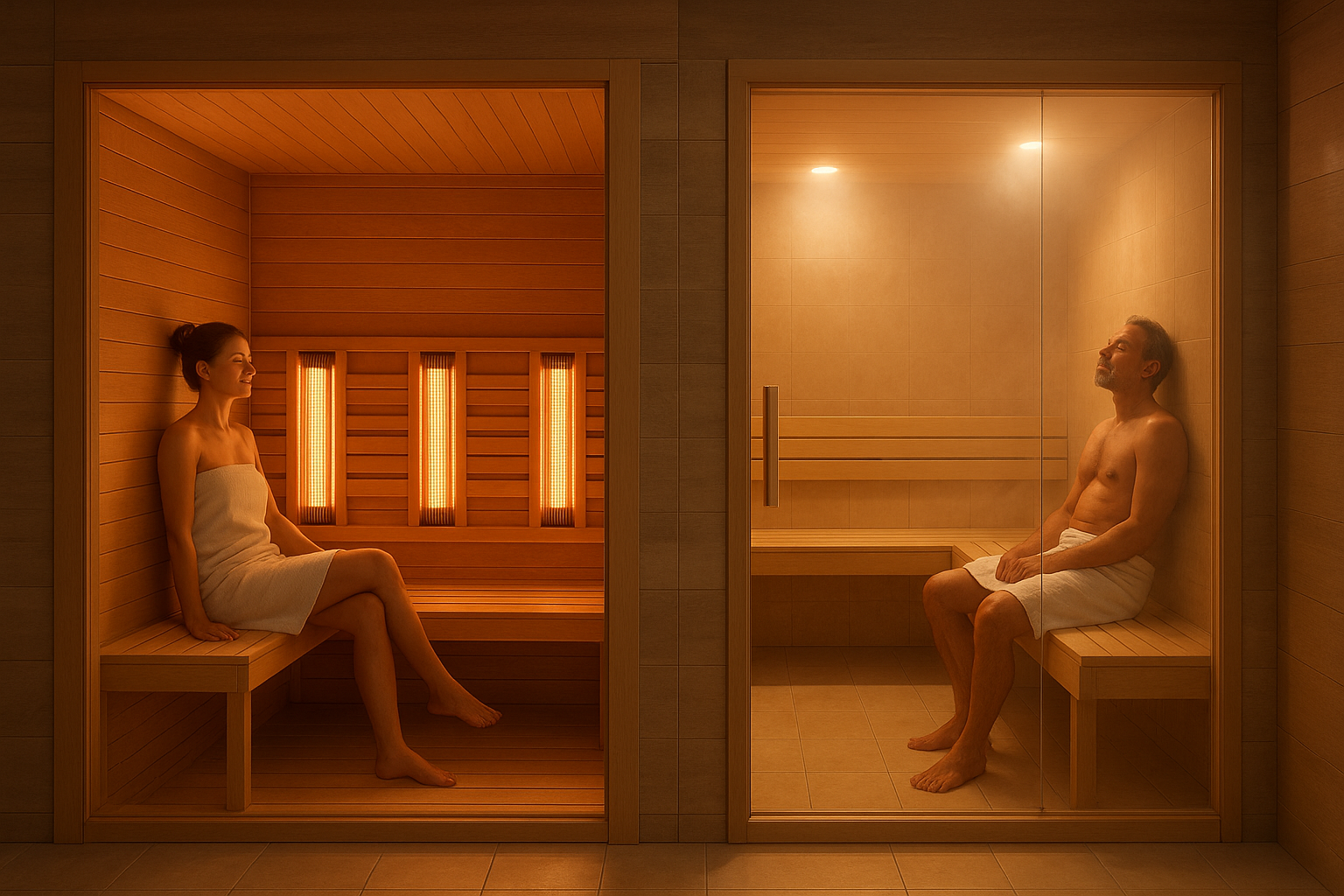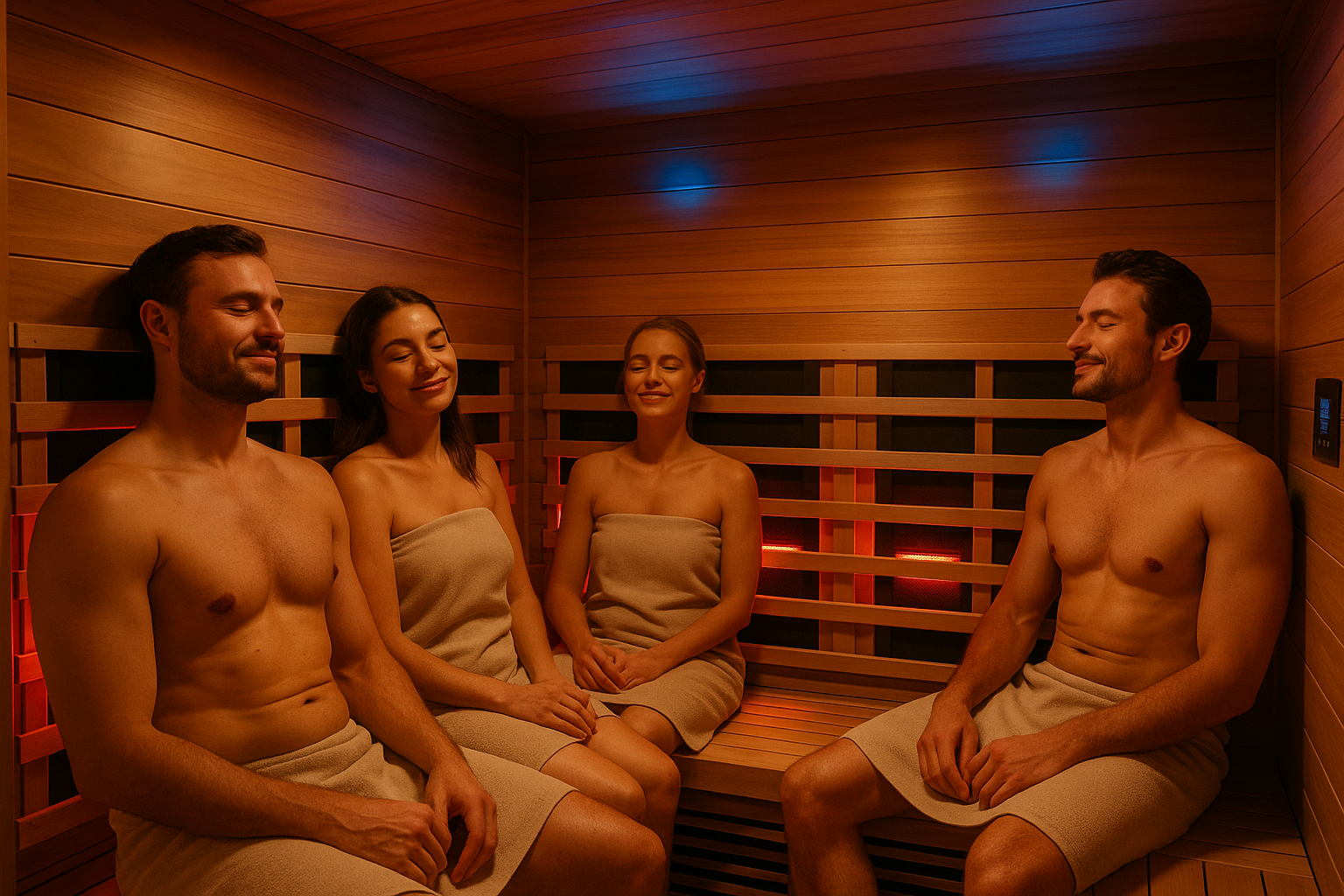Infrared Sauna vs Steam Sauna: Which One Is Right for You?
Standing between a sleek infrared cabin and a billowing steam room can feel like an impossible choice. Both promise deep relaxation, significant health benefits, and that coveted post-sauna glow—but they achieve these results through completely different mechanisms. Understanding how infrared and steam saunas work isn't just about personal preference; it's about selecting the right heat therapy to match your specific wellness goals.
Whether you're an athlete focused on muscle recovery, someone managing chronic stress, or simply looking to upgrade your home wellness routine, this comprehensive guide will help you make an informed decision about infrared vs steam saunas.
How Infrared and Steam Saunas Actually Work
Infrared Saunas: Precision Heat Therapy
Think of infrared saunas as targeted heat therapy at the cellular level. These modern wellness tools use invisible light wavelengths—near, mid, and far infrared—to warm your body directly without dramatically increasing the air temperature around you. Operating between 100–140°F (38–60°C), they create a comfortable environment that allows for extended sessions of 20–40 minutes.
The magic happens beneath the skin. Infrared wavelengths penetrate deep into muscles and tissues, reaching depths of 1.5 to 2 inches below the surface. This deep tissue heating is precisely why physical therapists, athletic trainers, and recovery specialists have embraced infrared technology as a legitimate therapeutic modality.
Steam Saunas: Traditional Immersive Heat
Steam rooms deliver the classic sauna experience that cultures around the world have enjoyed for centuries. Running at 110–120°F (43–49°C) with humidity levels approaching 100%, steam saunas create thick, enveloping warmth that heats your body from the outside in. The intensity is immediate and unmistakable—you'll be sweating profusely within the first few minutes.
Sessions in steam saunas are typically shorter (10–20 minutes) because the combination of heat and humidity creates an intense experience that challenges your cardiovascular system more directly than infrared alternatives.
The Science-Backed Health Benefits
Infrared Sauna Benefits
Accelerated Muscle Recovery and Pain Relief
Research from BMC Complementary Medicine and Therapies demonstrates that infrared wavelengths penetrate deeper tissue layers, producing significant reductions in delayed onset muscle soreness (DOMS) after exercise. Athletes using infrared therapy experienced faster recovery times and reduced lactate concentration post-training, according to findings published in the Journal of Athletic Training.
Dr. Brent Bauer from Mayo Clinic Integrative Medicine explains that infrared saunas "provide deep, gentle heat that reaches muscle tissue without stressing the cardiovascular system"—making them ideal for recovery-focused wellness routines.
Cardiovascular Health and Circulation
The cardiovascular benefits of regular sauna use are substantial and well-documented. A landmark study in Mayo Clinic Proceedings found that frequent sauna use was associated with a 40% lower risk of fatal heart events among men in Finland who maintained long-term sauna therapy practices. Research published in the International Journal of Environmental Research and Public Health linked consistent sauna use (2–4 times per week) to lower cardiovascular disease risk and improved endothelial function—the health of your blood vessel linings.
The American Heart Association published an advisory noting that sauna bathing improves arterial stiffness, blood pressure regulation, and overall circulation. These benefits stem from increased core body temperature, which triggers heat-shock proteins that enhance cellular resilience.
Skin Health and Anti-Aging Properties
Infrared wavelengths do more than just make you sweat. Research in Dermato-Endocrinology found that repeated near-infrared exposure increased collagen density and skin elasticity. A study in the Journal of Cosmetic Dermatology reported that infrared treatments reduced wrinkle depth by 20–25% after 12 weeks of consistent use.
The deep sweating induced by infrared heat also helps clear pores from the inside out, promoting clearer skin while simultaneously supporting long-term collagen production for improved skin structure and reduced fine lines.
Mental Wellness and Stress Reduction
The mental health benefits of infrared sauna use are backed by measurable biological markers. Research published in Frontiers in Psychology showed that both steam and infrared sauna use reduced salivary cortisol levels by 15–25%, directly improving mood and stress resilience.
Regular infrared heat exposure has been correlated with improved sleep efficiency through activation of the parasympathetic nervous system—your body's natural relaxation response. Harvard Health Publishing notes that sauna sessions promote endorphin release, contributing to better sleep quality and enhanced mental resilience.
Steam Sauna Benefits
Respiratory Health and Airway Support
This is where steam saunas truly excel. The Cleveland Clinic Wellness Team emphasizes that steam therapy "remains uniquely beneficial for respiratory health and skin hydration, particularly among chronic sinusitis or asthma patients." The humid air helps clear nasal congestion and improve bronchial flow, making steam rooms especially beneficial for people managing asthma, chronic bronchitis, or seasonal allergies.
Research in Respiratory Medicine Review demonstrated that humid air exposure improves mucociliary function—your airways' natural cleaning system. Johns Hopkins Pulmonary Division has recommended humid heat therapy for managing mild respiratory inflammation and mucus buildup.
Enhanced Skin Hydration and Deep Cleansing
Unlike dry heat environments, steam delivers moisture directly to your skin while you relax. Cleveland Clinic Health Essentials reports that steam saunas improve skin hydration and decrease transepidermal water loss thanks to the moisturized environment. The heat opens pores, allowing for deep cleansing while simultaneously hydrating the skin's surface for that healthy, natural glow.
Muscle Relaxation and Joint Relief
The enveloping warmth of steam penetrates stiff muscles and reduces joint discomfort, particularly beneficial after intense workouts or for individuals managing arthritis. The combination of heat and humidity creates a soothing environment that promotes muscle relaxation and flexibility.
Deep Stress Relief and Mental Calm
There's something primal and profoundly calming about sitting in thick steam. The environment forces you to slow down, breathe deeply, and disconnect from external stressors. Steam rooms create an immersive experience that triggers both physical and psychological relaxation.
Practical Considerations for Home Installation
Energy Efficiency and Operating Costs
If you're concerned about energy consumption (and your utility bills), infrared saunas offer a clear advantage. According to the US Department of Energy Efficiency Study, infrared saunas consume 30–45% less electricity than steam systems due to their lower operational temperature requirements.
Expect around 1.6–2.2 kWh per hour for infrared saunas versus 3–6 kWh per hour for steam saunas. Over months and years of regular use, this difference translates to significant savings on your energy bills while reducing your environmental footprint.
Installation Requirements and Maintenance
Infrared Saunas: Most modern infrared models are plug-and-play units requiring minimal installation expertise. No plumbing, no complicated ventilation systems, no construction permits—just plug it into a standard outlet and you're ready to begin your wellness journey. Maintenance is refreshingly simple: wipe down surfaces occasionally with a mild cleaner, and you're done.
Ready to explore easy-to-install home wellness solutions? Browse our collection of infrared saunas designed for convenient home use.
Steam Saunas: These require professional installation with dedicated plumbing lines, drainage systems, and proper ventilation to handle moisture. You'll need to commit to regular cleaning to prevent mold growth and mineral buildup from water use. The upfront investment is higher, and ongoing maintenance is more demanding.
User Experience and Comfort
Infrared: The gentler heat profile means you can comfortably stay in longer sessions, making infrared ideal for beginners or anyone sensitive to extreme temperatures. The heat builds gradually, allowing your body to adjust naturally. You'll sweat plenty, but the experience feels controlled and manageable.
Steam: The intensity hits you immediately upon entering. If you love that heavy, can't-escape-the-heat experience, steam is your ideal match. The combination of high humidity and heat creates an immersive environment that's not for everyone, especially those with heat sensitivity or certain cardiovascular conditions.
Looking for versatile options? Check out our hybrid sauna collection that combines the benefits of both technologies.
Quick Comparison: Infrared vs Steam
| Feature | Infrared Sauna | Steam Sauna |
|---|---|---|
| Temperature | 100–140°F (38–60°C) | 110–120°F (43–49°C) |
| Humidity | Low (10–20%) | Very High (near 100%) |
| Heat Type | Direct radiant infrared light | Humid, enveloping air |
| Session Length | 20–40 minutes | 10–20 minutes |
| Energy Use | 1.6–2.2 kWh/hour | 3–6 kWh/hour |
| Installation | Plug-and-play | Requires professional plumbing |
| Maintenance | Minimal (occasional cleaning) | Regular (mold prevention, mineral buildup) |
| Best For | Muscle recovery, pain relief, skin anti-aging | Respiratory support, maximum hydration |
| Beginner-Friendly | Yes, very gentle | Moderate, can be intense |
| Tissue Penetration | Deep (1.5–2 inches) | Surface level |
Which Sauna Should You Choose?
Choose Infrared If You Want:
- Deeper tissue benefits and enhanced muscle recovery for athletic performance
- Lower operating temperatures for longer, more comfortable sessions
- Energy efficiency and easy home installation without professional contractors
- Skin anti-aging benefits through collagen stimulation and deep cleansing
- A beginner-friendly option that's gentle yet therapeutically effective
- Lower long-term operating costs and minimal maintenance requirements
Choose Steam If You Prefer:
- The intense, traditional sauna experience with high humidity
- Respiratory and sinus relief for asthma, allergies, or bronchitis
- Maximum skin hydration and immediate moisture benefits
- That enveloping, humidity-filled heat that creates total immersion
- The classic spa experience you might find at upscale wellness centers
Harvard Health Publishing summarizes it well: "Both sauna types can improve cardiovascular response and mental relaxation; the ideal choice depends on thermal tolerance and goals." Many wellness enthusiasts don't choose at all—they alternate between both types to maximize the unique benefits each offers.
The Bottom Line
There's no universally "better" option between infrared and steam saunas—only the better option for your specific needs, preferences, and wellness goals. Infrared saunas excel at muscle recovery, pain relief, energy efficiency, and convenience, while steam rooms dominate for respiratory health, skin hydration, and that intense traditional sauna experience.
The most effective sauna is ultimately the one you'll use consistently. Regular use is where the long-term health benefits emerge—whether that's improved cardiovascular function, better stress management, enhanced recovery, or simply a dedicated space for mental decompression.
If you're leaning toward the convenience, efficiency, and therapeutic depth of infrared technology, explore our complete home sauna collection to find the perfect fit for your space and wellness objectives.
For more comprehensive information on the science behind heat therapy and cardiovascular health, visit Harvard Health Publishing's guide to sauna use.
Frequently Asked Questions
Which sauna burns more calories?
Infrared saunas may burn slightly more calories due to deeper tissue heating and elevated heart rate during sessions, but the difference is modest. A Mayo Clinic analysis noted that both types increase calorie burn primarily through cardiovascular response rather than direct fat oxidation. Neither should replace regular exercise for weight management, but both can complement an active lifestyle.
Are steam saunas better for skin?
It depends on your specific skin goals. Steam hydrates skin beautifully and opens pores for deep cleansing, while infrared stimulates collagen production for long-term anti-aging benefits. Research shows steam provides immediate hydration and decreases transepidermal water loss, while infrared therapy increases collagen density and skin elasticity over time. Both support skin health through different mechanisms—steam for immediate moisture and cleansing, infrared for structural improvements.
Can I use a sauna every day?
Yes, most healthy adults can safely use either type daily with proper hydration. Listen to your body, stay well-hydrated before and after sessions, and start with shorter durations if you're new to regular sauna use. If you have cardiovascular conditions, diabetes, low blood pressure, are pregnant, or take medications that affect temperature regulation, consult your healthcare provider before establishing a regular sauna routine.
Which sauna is safer for beginners?
Infrared saunas are generally more beginner-friendly because the lower temperatures and gentler heat allow your body to adjust gradually over multiple sessions. You're less likely to feel overwhelmed, lightheaded, or uncomfortable during your first experiences. Start with 15-20 minute sessions and work your way up as your heat tolerance develops.
How long should each session last?
Infrared sessions typically run 20–40 minutes, while steam sessions are shorter at 10–20 minutes due to the intensity of combined heat and humidity. Start on the lower end of these ranges and gradually work your way up as you become comfortable. Always exit immediately if you feel dizzy, nauseated, or overly uncomfortable—these are signs your body needs a break.
Which sauna is better for heart health?
Both offer significant cardiovascular benefits. Research published in the International Journal of Environmental Research and Public Health found that both infrared and steam saunas were associated with reduced cardiovascular disease risk and improved blood pressure regulation. However, if you have existing heart conditions, consult your doctor before starting any sauna routine. The infrared option may be better tolerated due to lower ambient temperatures and less cardiovascular stress.
Can people with asthma use these saunas?
Steam saunas may offer respiratory benefits for people with asthma or allergies because the humidity opens airways and loosens congestion. However, individual responses vary significantly—some people find high humidity triggering rather than helpful. Start cautiously with shorter sessions and discontinue if symptoms worsen. Infrared saunas don't provide the same respiratory humidity benefits but may be better tolerated by those sensitive to intense heat or who find humid environments uncomfortable.
Do saunas actually help with detoxification?
While sweating does eliminate some toxins and heavy metals through the skin, Harvard Health Publishing notes that direct detoxification evidence remains limited. Your liver and kidneys perform the majority of detoxification work in your body. That said, both sauna types support your body's natural detox pathways through increased circulation, enhanced lymphatic flow, and sweating—just don't expect miracles or dramatic "cleansing" effects.
How do heat-shock proteins work in sauna therapy?
Dr. Andrew Huberman from Stanford University explains that sauna exposure increases core body temperature, which triggers heat-shock proteins—specialized molecules that enhance cellular resilience, reduce inflammation, and support longevity. These proteins help repair damaged proteins in cells and may contribute to the cardiovascular and longevity benefits observed in regular sauna users. The effect requires reaching and maintaining elevated core temperature, which both sauna types can achieve.
Is one better for skin conditions like eczema or acne?
Individual responses vary significantly. Steam can soothe dry, irritated skin and provide moisture relief for some eczema sufferers, while infrared's deep cleansing and collagen stimulation may benefit acne-prone skin through improved circulation and pore clearing. Some people with eczema find high humidity helpful, while others need the drier heat of infrared to avoid irritation. Start with shorter sessions to test your skin's response before committing to regular use.
How much electricity does a home sauna consume annually?
Assuming 4 sessions per week at 30 minutes per session, an infrared sauna consuming 2 kWh per hour would use approximately 208 kWh annually. At the US average electricity rate of $0.14 per kWh, that's roughly $29 per year. A steam sauna consuming 5 kWh per hour would use approximately 520 kWh annually, costing around $73 per year. Actual costs vary based on usage frequency, session length, and local electricity rates.
Can I alternate between infrared and steam saunas?
Absolutely. Many wellness enthusiasts use infrared for muscle recovery and regular daily sessions, then enjoy steam rooms for respiratory benefits or when they want that intense, traditional experience. Alternating allows you to enjoy the unique therapeutic advantages of each type. Some people use infrared 3-4 times weekly and steam once weekly for variety and comprehensive benefits.
Are there risks to daily sauna use?
Daily use is generally safe for healthy adults, but overuse can lead to dehydration, electrolyte imbalances, or heat exhaustion if you're not careful about hydration. Certain conditions require medical guidance before regular sauna use: pregnancy, cardiovascular disease, low blood pressure, recent heart attack or stroke, kidney disease, or medications that affect temperature regulation (like certain blood pressure medications or diuretics). Always discuss with your healthcare provider if you have any concerns.
What are the environmental sustainability differences?
Infrared saunas are more environmentally sustainable due to significantly lower energy consumption (30–45% less electricity). Steam saunas also require substantial water use for steam generation, adding to their environmental footprint. If sustainability is a priority, infrared saunas offer clear advantages in both energy efficiency and resource conservation while delivering comparable health benefits.









Leave a comment
This site is protected by hCaptcha and the hCaptcha Privacy Policy and Terms of Service apply.